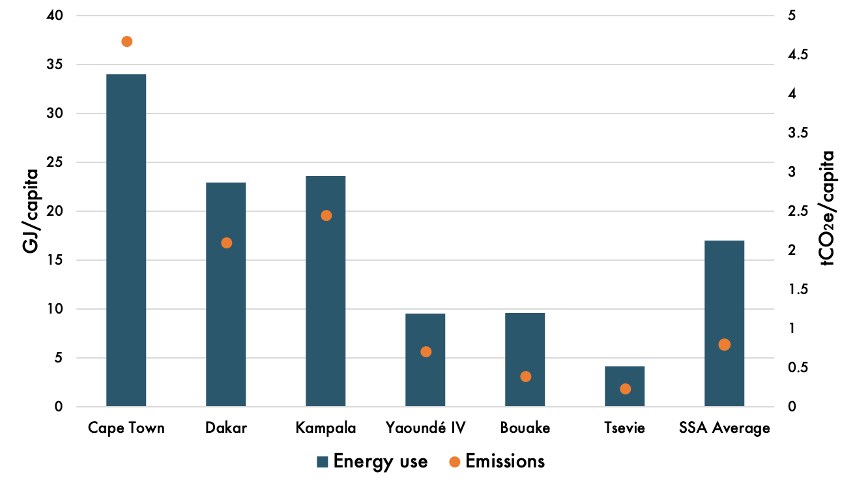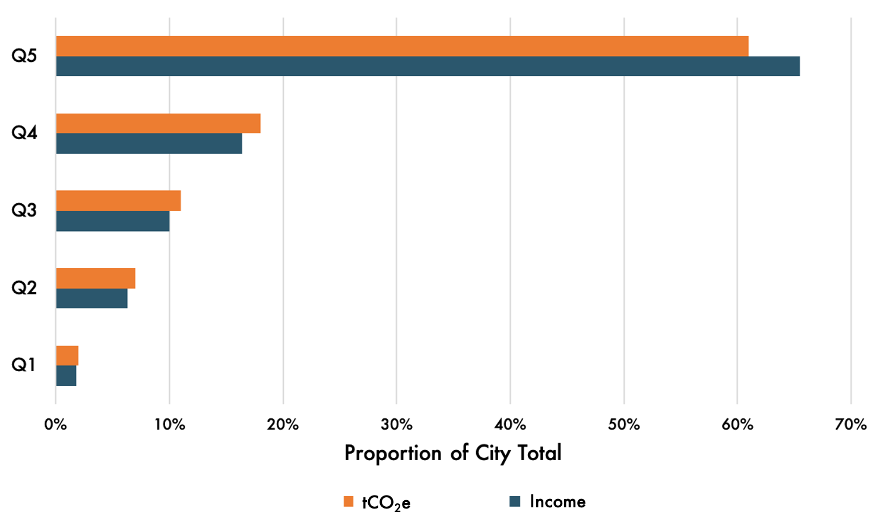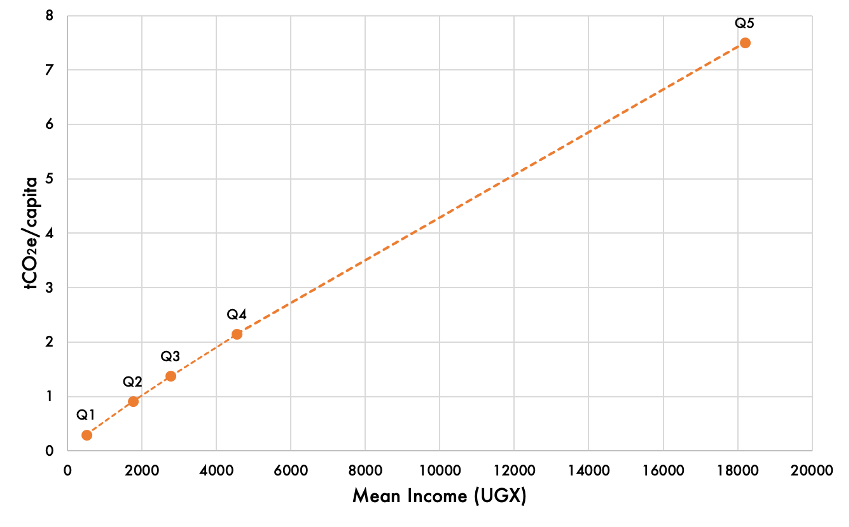Kampala, Uganda’s capital city, joined the Covenant of Mayors in sub-Saharan Africa in 2015, thereby committing to establish and implement strategies for sustainable low-carbon development. The Kampala Capital City Authority (KCCA) – the legal entity responsible for city operations – launched its energy and climate action plan in 2016.1 This document defines the city’s priorities for a low-carbon energy transition and supports implementation of various national strategies, in particular, Uganda’s National Development Plan (NDP) III.2 Its energy-related priorities include:
- Promoting clean cooking
- Investing in locally produced renewable electricity
- Incentivizing distributed small-scale renewable energy deployments
However, Kampala’s emissions distribution reflects severe socioeconomic and energy disparities. Without reform, the city’s energy strategy will likely contribute to increased energy poverty and inequality, an outcome completely contrary to its intentions.
The overlooked carbon inequalities in Kampala
Kampala is Uganda’s largest urban settlement, with an estimated population of 1.7 million in 2020.3 It accounts for most of Uganda’s industrial and commercial activities and generates 22.5% of national GDP.4 Per capita, Kampala’s energy use (23.7 GJ) and emissions (2.4 tCO2e) are higher than the sub-Saharan African (SSA) average, owing to a wealthier populace, a dense transport infrastructure, and the concentration of industrial activities within its municipal boundaries (Figure 1).5
FIGURE 1. Energy use and emissions per capita across selected SSA cities

Note: Data are from various years (most recent available).
In 2014, Kampala’s total final energy demand was estimated at 35 million Gigajoules (GJ), largely driven by the transport sector. That same year, Kampala generated 3.7 MtCO2e, with the transport sector alone accounting for 39% of the total.6 However, while these numbers exceed those in many other African cities, they disguise deep inequalities.
Individuals in the top quintile (Q5) of Kampala’s population often own multiple household appliances and use private transport, thereby consuming several times more energy and emitting twelve to twenty-five times more than individuals in the bottom quintiles. In fact, these embedded inequalities mean that those in the top quintile produce two-thirds of total city emissions, while the bottom quintile (Q1) account for just 2% (Figure 2). Yet Kampala’s poorest residents live overwhelmingly in settlements most vulnerable to climate change. Worse, low-income households lack access to modern energy supplies, and still largely rely on traditional energy sources such as charcoal or firewood for cooking and heating, which can be degradative to health.7,8 Kampala must account for these massive inequalities in order to create a genuinely inclusive and socially just energy system.
FIGURE 2a. & 2b. Kampala income quintiles and associated GHG emissions (2014)


The overlooked role of a ‘Just’ energy transition in Kampala’s energy strategy
Both KCCA’s energy strategy and the NDP III attempt to address problems in the energy system that undermine socioeconomic development and social welfare. However, three key gaps stand in the way of significant progress towards a genuinely inclusive and socially just energy system.9
- No reference to current or future inequalities in the energy system. Where the strategy identifies socio-economic opportunities of the transition, it tends to focus on the creation of green jobs. But a truly just energy transition must be about more than job creation. It needs to embrace other key elements like accessibility and affordability, a shift in ownership of energy, and transparent engagement. Creating green jobs is certainly a move in the right direction, but it is unclear whether (and how) the local authority will ensure that the benefits of new wealth and economic opportunity will be distributed fairly.
- Too much focus on generation and not enough on energy distribution and governance. Simply adding power supply will not address many of Kampala’s severe energy challenges. The end user’s experience should be considered the energy system’s central socioeconomic goal, not an afterthought. Failing to engage end-users on the kind of distribution models selected, and the form, reliability and cost of distributed energy significantly undermines the importance of energy distribution in advancing social justice goals.10
- No clear pathways identified to improve energy accessibility and affordability. Small-scale distributed renewables are clearly an important solution, but they have the potential to exacerbate inequalities as wealthier customers depend less on the grid, thereby reducing the utility’s income and further inflating tariffs already out of reach for many Ugandan households.11 A more equitable energy system should prioritize enabling all households to access sufficient energy (not just electricity), without having to sacrifice other essential household expenditures.
How can Kampala be more proactive in driving a just energy transition?
- Identify who is being impacted by the current defective energy system and how. Building a comprehensive picture of the current energy system and identifying causal linkages with socioeconomic development indicators is the first step to developing a whole energy system approach that focuses on more than just the elements directly impacted by a low carbon transition.
- Conduct meaningful and transparent engagement with social groups and communities on the kind of distribution models to be selected, and the form, reliability and cost of distributed energy.
- Identify diverse solutions in terms of scale and technology that are contextually relevant to Kampala and best suited to address local energy demands, particularly those of residents who have significant vested interest in the future form, operation, and environmental sustainability of the energy system.
